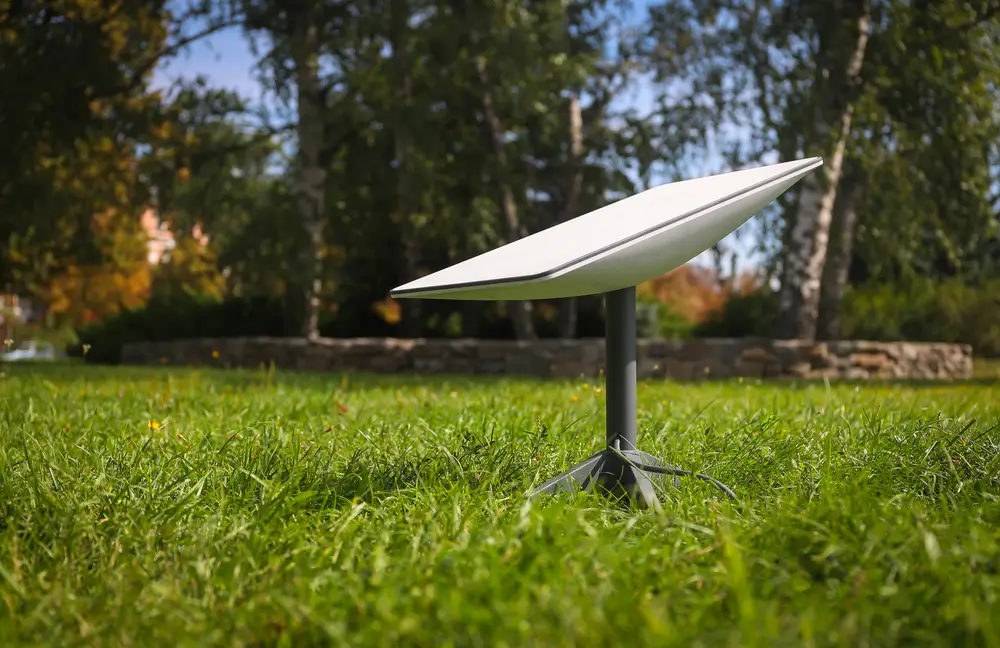
The Starlink dish, also known as Dishy McFlatface, is a key component of SpaceX’s ambitious Starlink project, which aims to provide high-speed, low-latency internet access across the globe, especially in remote and underserved areas. This compact, advanced piece of technology plays a crucial role in establishing a direct link with Starlink’s constellation of low Earth orbit (LEO) satellites.
Design and Specifications
1. Physical Characteristics:
- Shape and Size: The Starlink dish is a flat, circular device, approximately 23 inches (58 cm) in diameter, designed to be both durable and lightweight. This compact size makes it easy to install in a variety of locations.
- Antenna: It contains a phased array antenna, which is capable of electronically steering the beam without moving the dish, allowing for rapid and precise alignment with satellites.
- Weather Resistance: Built to withstand extreme weather conditions, including heavy snow, rain, and wind, the dish is equipped with a heater to melt snow and prevent signal obstruction.
2. Technical Features:
- High Bandwidth: The dish is designed to handle high data rates, supporting internet speeds of up to 150 Mbps and beyond, depending on the location and network load.
- Low Latency: With latency as low as 20 ms, the dish ensures a responsive internet experience, suitable for activities like video conferencing, online gaming, and real-time data transmission.
- Autonomous Operation: The dish is self-orienting, using motors to automatically adjust its position for optimal signal reception. This feature simplifies installation and maintenance.
Installation Process
1. Equipment Included:
- The Starlink kit includes the dish, a mounting tripod, a Wi-Fi router, power supply, and necessary cables. Users may need additional mounting hardware depending on their specific installation needs.
2. Installation Steps:
- Site Selection: Choose an installation site with a clear view of the sky, free from obstructions like trees or buildings, to ensure unobstructed satellite communication.
- Mounting: Secure the dish on the mounting tripod or a custom mount. The dish should be placed as high as possible to avoid potential obstructions.
- Connection: Connect the dish to the power supply and Wi-Fi router using the provided cables. The dish will automatically align itself with the satellites.
- Activation: Use the Starlink app to complete the setup process, including registering the dish and optimizing its placement.
Performance and Reliability
1. Speed and Latency:
- Users typically experience download speeds ranging from 50 to 150 Mbps and upload speeds of 10 to 20 Mbps, with latency between 20 to 40 ms. These performance metrics can vary based on location, network traffic, and environmental factors.
2. Reliability:
- The dish is designed to provide reliable internet service even in challenging environments. Its phased array antenna and advanced signal processing capabilities help maintain a stable connection, even during adverse weather conditions.
Benefits and Applications
1. Accessibility:
- Starlink’s dish brings high-speed internet to remote and rural areas where traditional internet services are unavailable or unreliable. This accessibility has significant implications for education, healthcare, and economic development in underserved regions.
2. Mobility:
- With a portable design, the Starlink dish can be used in various settings, including residential homes, RVs, boats, and remote work sites. This flexibility makes it an attractive option for users who require reliable internet access on the go.
3. Emergency Response:
- The dish’s rapid deployment capability is invaluable in emergency situations, providing critical communication links in disaster-stricken areas where infrastructure is damaged or nonexistent.
Cost and Subscription
1. Initial Cost:
- The Starlink kit costs approximately $599, which includes the dish, mounting tripod, Wi-Fi router, and cables.
2. Subscription Fees:
- The monthly subscription fee for Starlink internet service is around $110, covering unlimited data usage and access to the satellite network.
FAQs
1. How does the Starlink dish handle adverse weather conditions?
- The dish is equipped with a heater to melt snow and is designed to withstand heavy rain and strong winds. Its weather-resistant design ensures continuous operation in various environmental conditions.
2. What is the typical installation time for the Starlink dish?
- Installation can be completed within an hour, depending on the mounting method and site preparation. The dish’s self-orienting feature simplifies the setup process.
3. Can the Starlink dish be used in mobile applications?
- Yes, the Starlink dish can be used in mobile settings like RVs and boats. However, it requires a clear view of the sky to maintain a stable connection with the satellites.
4. Is professional installation required for the Starlink dish?
- While professional installation is not required, it can be beneficial for users who are not comfortable with the setup process or who require a more complex mounting solution.
5. How does the Starlink dish compare to traditional satellite internet services?
- The Starlink dish offers significantly lower latency and higher speeds compared to traditional geostationary satellite internet services, providing a more responsive and reliable internet experience.
The Starlink dish represents a significant advancement in satellite internet technology, offering high-speed, low-latency internet access to areas that were previously underserved. Its innovative design and autonomous operation make it an accessible and reliable option for a wide range of users.

